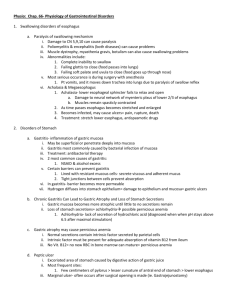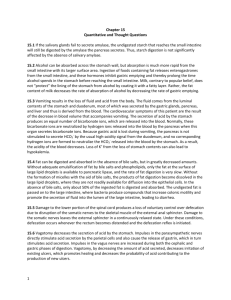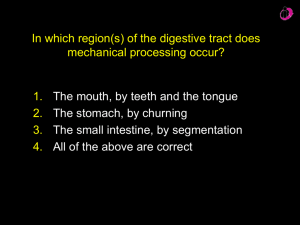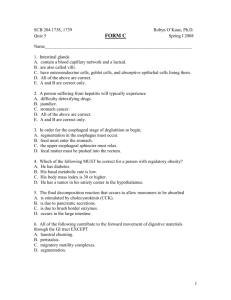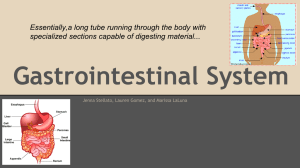phys chapter 66 [10-4
advertisement
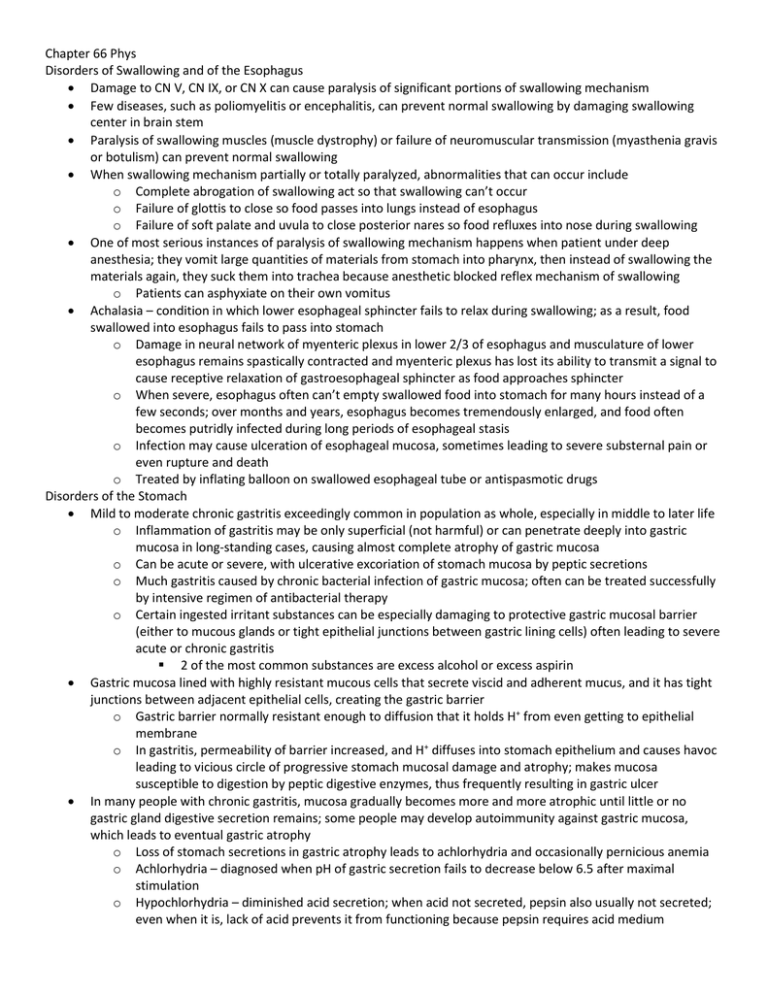
Chapter 66 Phys Disorders of Swallowing and of the Esophagus Damage to CN V, CN IX, or CN X can cause paralysis of significant portions of swallowing mechanism Few diseases, such as poliomyelitis or encephalitis, can prevent normal swallowing by damaging swallowing center in brain stem Paralysis of swallowing muscles (muscle dystrophy) or failure of neuromuscular transmission (myasthenia gravis or botulism) can prevent normal swallowing When swallowing mechanism partially or totally paralyzed, abnormalities that can occur include o Complete abrogation of swallowing act so that swallowing can’t occur o Failure of glottis to close so food passes into lungs instead of esophagus o Failure of soft palate and uvula to close posterior nares so food refluxes into nose during swallowing One of most serious instances of paralysis of swallowing mechanism happens when patient under deep anesthesia; they vomit large quantities of materials from stomach into pharynx, then instead of swallowing the materials again, they suck them into trachea because anesthetic blocked reflex mechanism of swallowing o Patients can asphyxiate on their own vomitus Achalasia – condition in which lower esophageal sphincter fails to relax during swallowing; as a result, food swallowed into esophagus fails to pass into stomach o Damage in neural network of myenteric plexus in lower 2/3 of esophagus and musculature of lower esophagus remains spastically contracted and myenteric plexus has lost its ability to transmit a signal to cause receptive relaxation of gastroesophageal sphincter as food approaches sphincter o When severe, esophagus often can’t empty swallowed food into stomach for many hours instead of a few seconds; over months and years, esophagus becomes tremendously enlarged, and food often becomes putridly infected during long periods of esophageal stasis o Infection may cause ulceration of esophageal mucosa, sometimes leading to severe substernal pain or even rupture and death o Treated by inflating balloon on swallowed esophageal tube or antispasmotic drugs Disorders of the Stomach Mild to moderate chronic gastritis exceedingly common in population as whole, especially in middle to later life o Inflammation of gastritis may be only superficial (not harmful) or can penetrate deeply into gastric mucosa in long-standing cases, causing almost complete atrophy of gastric mucosa o Can be acute or severe, with ulcerative excoriation of stomach mucosa by peptic secretions o Much gastritis caused by chronic bacterial infection of gastric mucosa; often can be treated successfully by intensive regimen of antibacterial therapy o Certain ingested irritant substances can be especially damaging to protective gastric mucosal barrier (either to mucous glands or tight epithelial junctions between gastric lining cells) often leading to severe acute or chronic gastritis 2 of the most common substances are excess alcohol or excess aspirin Gastric mucosa lined with highly resistant mucous cells that secrete viscid and adherent mucus, and it has tight junctions between adjacent epithelial cells, creating the gastric barrier o Gastric barrier normally resistant enough to diffusion that it holds H+ from even getting to epithelial membrane o In gastritis, permeability of barrier increased, and H+ diffuses into stomach epithelium and causes havoc leading to vicious circle of progressive stomach mucosal damage and atrophy; makes mucosa susceptible to digestion by peptic digestive enzymes, thus frequently resulting in gastric ulcer In many people with chronic gastritis, mucosa gradually becomes more and more atrophic until little or no gastric gland digestive secretion remains; some people may develop autoimmunity against gastric mucosa, which leads to eventual gastric atrophy o Loss of stomach secretions in gastric atrophy leads to achlorhydria and occasionally pernicious anemia o Achlorhydria – diagnosed when pH of gastric secretion fails to decrease below 6.5 after maximal stimulation o Hypochlorhydria – diminished acid secretion; when acid not secreted, pepsin also usually not secreted; even when it is, lack of acid prevents it from functioning because pepsin requires acid medium Pernicious anemia – normal gastric secretions contain intrinsic factor, secreted by parietal cells (that also secrete HCl); intrinsic factor must be present for adequate absorption of vitamin B12 from ileum o Intrinsic factor combines with vitamin B12 in stomach and protects it from being digested and destroyed as it passes into small intestine; when intrinsic factor-vitamin B12 complex reaches terminal ileum, intrinsic factor binds with receptors on ileal epithelial surface, making it possible for B12 to be absorbed o Without intrinsic factor, can’t get adequate amount of B12 to be made available from foods to cause newly forming RBCs to mature in bone marrow Peptic ulcer – excoriated area of stomach or intestinal mucosa caused principally by digestive action of gastric juice or upper small intestine secretions o Marginal ulcer – peptic ulcer that occurs wherever surgical opening such as gastrojejunostomy has been made between stomach and jejunum o Ulcers occur most frequently near pylorus and rarely near cardiac sphincter with repeated gastric reflux Usual cause of peptic ulceration is imbalance between rate of secretion of gastric juice and degree of protection afforded by gastroduodenal mucosal barrier and neutralization of gastric acid by duodenal juices o Mucous secreted by compound mucous glands in lower esophagus, mucous neck cells of gastric glands, deep pyloric glands that secrete mainly mucus, and Brunner’s glands of upper duodenum o Duodenum protected by alkalinity of small intestinal secretions and pancreatic secretions o Alkaline secretions also neutralize HCl of gastric juice, inactivating pepsin and preventing digestion of mucosa o Large amounts of bicarbonate ions provided by pancreatic secretions, Brunner’s glands in duodenal wall, and bile coming from liver o 2 feedback control mechanisms normally ensure that neutralization of gastric juices complete When excess acid enters duodenum, it inhibits gastric secretion and peristalsis in stomach, both by nervous reflexes and by hormonal feedback from duodenum, thereby decreasing rate of gastric emptying Presence of acid in small intestine liberates secretin from intestinal mucosa, which then passes by way of blood to pancreas to promote rapid secretion of pancreatic juice, which also contains high concentration of sodium bicarb, thus making still more sodium bicarb available for neutralization of acid o Peptic ulcer can thus be caused by excess secretion of acid and pepsin by gastric mucosa or diminished ability of gastroduodenal mucosal barrier to protect against digestive properties of stomach acid-pepsin secretion 75% of peptic ulcer patients have chronic infection of terminal portions of gastric mucosa and initial portions of duodenal mucosa, most often caused by H. pylori o Once infection begins, it can last a lifetime unless eradicated by antibacterial therapy o Bacterium capable of penetrating mucosal barrier both by virtue of its physical capability to burrow through barrier and by releasing ammonium that liquefies barrier and stimulates secretion of HCl; as a result, strong acidic digestive juices of stomach secretions penetrate into underlying epithelium and literally digest GI wall, thus leading to peptic ulceration In many people with ulcers in initial portion of duodenum, rate of gastric acid secretion greater than normal o Part of increased secretion may be stimulated by bacterial infection Other factors that predispose to ulcers include smoking (because of increased nervous stimulation of stomach secretory glands), alcohol (because it breaks down mucosal barrier), and aspirin and other NSAIDs (have strong propensity for breaking down mucosal barrier) Almost all patients with peptic ulceration can be treated effectively by use of antibiotics and administration of acid-suppressant drug (especially ranitidine, an antihistamine that blocks stimulatory effect of histamine on gastric glands histamine2 receptors, reducing gastric acid by 70-80%) o Previous therapies involved excision of stomach (reducing stomach acid-peptic juices), cutting vagus nerves (blocking almost all secretion of acid and pepsin); both of previous not very effective as basal stomach secretion returned after a few months, and ulcers also returned often Disorders of Small Intestine Failure of pancreas to secrete pancreatic juice into small intestine – lack of pancreatic secretion frequently occurs in pancreatitis, when pancreatic duct blocked by gallstone at papilla of Vater, or after head of pancreas has been removed because of malignancy o Loss of pancreatic juice means loss of many digestive enzymes, resulting in up to 60% of fat entering small intestine not being absorbed, as well as 1/3-1/2 of proteins and carbs o Large portions of ingested food can’t be used for nutrition, and copious fatty feces excreted Pancreatitis can occur as acute pancreatitis or chronic pancreatitis o Most common cause of pancreatitis is drinking excess alcohol; second most common cause is blockage of papilla of Vater by gallstone (both together are more than 90% of cases) o When gallstone blocks papilla of Vater, enzymes build up and eventually so much trypsinogen accumulates that it overcomes trypsin inhibitor in secretions and small quantity of trypsinogen because activated, then it starts activating all the enzymes around it o Enzymes rapidly digest large portions of pancreas, sometimes completely and permanently destroying ability of pancreas to secrete digestive enzymes Sprue – diseases that cause decreased absorption by intestinal mucosa o Idiopathic sprue (celiac disease of children or gluten enteropathy) results from toxic effects of gluten In those who are susceptible, gluten has direct destructive effect on intestinal enterocytes o In milder forms of disease, only microvilli of absorbing enterocytes on villi destroyed, decreasing absorptive surface area o In most severe forms, villi become blunted and disappear altogether, further reducing absorptive area o Removal of wheat and rye flour from diet frequently results in cure, especially in children o Tropical sprue – occurs in tropics and can be treated with antibacterial agents; no specific bacterium implicated, but inflammation of intestinal mucosa exists and is helped by antibiotics o In early stages of sprue, intestinal absorption of fat more impaired than absorption of other digestive products; causes steatorrhea o In severe cases of sprue, in addition to malabsorption of fats, there is also impaired absorption of proteins, carbs, calcium, vitamin K, folic acid, and vitamin B12 Person suffers from severe nutritional deficiency (wasting of body), osteomalacia (demineralization of bones because of lack of calcium), inadequate blood coagulation caused by lack of vitamin K, and macrocytic anemia of pernicious anemia type (lack of B12 and folic acid) Disorders of Large Intestine Constipation – slow movement of feces through large intestine; often associated with large quantities of dry, hard feces in descending colon that accumulate because of overabsorption of fluid o Any pathology of intestines that obstructs movement of intestinal contents, such as tumors, adhesions that constrict intestines, or ulcers, can cause constipation o Frequent functional cause of constipation is irregular bowel habits that have developed through a lifetime of inhibition of normal defecation reflexes o If one doesn’t allow defecation to occur when defecation reflexes are excited, or if one overuses laxatives to take the place of natural bowel function, the reflexes themselves become progressively less strong over months or years, and colon becomes atonic o If a person establishes regular bowel habits early in life, defecating when gastrocolic and duodenocolic reflexes cause mass movements in large intestine, development of constipation in later life is much less likely o Can also result from spasm of small segment of sigmoid colon; motility normall weak in large intestine, so even a slight degree of spasm often capable of causing serious constipation After constipation has continued for several days and excess feces have accumulated above spastic sigmoid colon, excessive colonic secretions often lead to a day or so of diarrhea Leads to alternating bouts of diarrhea and constipation Megacolon (Hirschsprung’s Disease) – severe constipation can cause this because of accumulation of fecal matter that is not being passed o Frequent cause is lack of or deficiency of ganglion cells in myenteric plexus in segment of sigmoid colon o Neither defecation reflexes nor strong peristaltic motility can occur in this area o Sigmoid colon becomes small and almost spastic, while feces accumulateproximal to this area, causing megacolon in ascending, transverse, and descending colons Diarrhea – results from rapid movement of fecal matter through large intestine o Enteritis (inflammation of intestinal tract) – usually caused by virus or bacteria; infection most extensive in large intestine and distal end of ileum Infection makes mucosa become irritated, and rate of secretion becomes greatly enhanced Motility of intestinal wall usually increases, allowing large quantities of fluid to be made available for washing infectious agent toward anus, and at same time, strong propulsive movements propel this fluid forward o Cholera – toxin directly stimulates excessive secretion of electrolytes and fluid from crypts of Lieberkühn in distal ileum and colon Loss of fluid and electrolytes can be so debilitating within several days that death can ensue Most important therapy is to replace fluid and electrolytes as rapidly as they are lost, mainly by giving patient intravenous solutions Up to 50% die without treatment, but almost none do with proper therapy and antibiotics o Psychogenic diarrhea – periods of nervous tension lead to excessive stimulation of PNS, which greatly excites both motility and excess secretion of mucus in distal colon o Ulcerative colitis – disease in which extensive areas of walls of large intestine become inflamed and ulcerated; motility of ulcerated colon often so great that mass movements occur much of the day rather than for 10-30 minutes (usual) Colon’s secretions greatly enhanced Cause unknown; could be allergic or immune destructive effect or chronic bacterial infection Strong hereditary tendency for susceptibility to ulcerative colitis Once condition has progressed far enough, ulcers seldom heal until ileostomy performed to allow small intestinal contents to drain to exterior rather than pass through colon; even then ulcers sometimes fail to heal, and only solution might be surgical removal of entire colon Defecation normally initiated by accumulating feces in rectum, which causes spinal cord-mediated defecation reflex passing from rectum to conus medullaris of spinal cord and then back to descending colon, sigmoid, rectum, and anus o When spinal cord injured somewhere between conus medullaris and brain, voluntary portion of defecation act blocked while basic cord reflex for defecation is still intact o Loss of voluntary aid to defecation (loss of increased abdominal pressure and relaxation of voluntary anal sphincter) makes defecation difficult in person with this type of upper cord injury o Because cord defecation reflex can still occur, small enema to excite action of this cord reflex, usually given in morning shortly after meal, can often cause adequate defecation (allows for control of feces) General Disorders of GI Tract Vomiting – upper GI tract rids itself of its contents when almost any part of upper tract becomes excessively irritated, overdistended, or even overexcitable o Excessive distention or irritation of duodenum provides especially strong stimulus for vomiting o Nerve impulses transmitted from irritable organ by both vagal and sympathetic afferent nerve fibers to multiple distributed nuclei in brain stem that altogether are called “vomiting center” o From there, motor impulses that cause actual vomiting transmitted by way of CN V, CN VII, CN IX, CN X, and CN XII to upper GI tract, through vagal and sympathetic nerves to lower tract, and through spinal nerves to diaphragm and abdominal muscles o Antiperistalsis – prelude to vomiting; peristalsis up the digestive tract instead of down (may happen minutes before actual vomiting) May begin as far down as ileum Pushing contents back up causes higher organs (duodenum or stomach) to become overly distended, which then excites the actual vomiting At onset of vomiting, strong intrinsic contractions occur in both duodenum and stomach, along with partial relaxation of esophageal-stomach sphincter, thus allowing vomitus to begin moving from stomach into esophagus o Once vomiting center has been sufficiently stimulated and vomiting act instituted, first effects are deep breath, raising of hyoid bone and larynx to pull upper esophageal sphincter open, closing of glottis to prevent vomitus flow into lungs, and lifting of soft palate to close posterior nares Next comes strong downward contraction of diaphragm along with simultaneous contraction of all abdominal wall muscles, squeezing stomach between diaphragm and abdominal muscles, building intragastric pressure to high level Lower esophageal sphincter relaxes completely, allowing expulsion of gastric contents upward through esophagus Vomiting can be caused by nervous signals arising in areas of brain o Small area located bilaterally on floor of 4th ventricle (chemoreceptor trigger zone for vomiting); electrical stimulation of this area can initiate vomiting; administration of certain drugs (apomorphine, morphine, and some digitalis derivatives) can directly stimulate chemoreceptor trigger zone and initiate vomiting; destruction of this area blocks vomiting by this stimulus, but irritability of GI tract can still cause vomiting o Rapidly changing direction or rhythm of motion of body can cause certain people to vomit Motion stimulates receptors in vestibular labyrinth of inner ear, and from there impulses transmitted mainly by way of brain stem vestibular nuclei into cerebellum, then to chemoreceptor trigger zone, and finally to vomiting center to cause vomiting Nausea – conscious recognition of subconscious excitation in area of medulla closely associated with or part of the vomiting center; can be caused by irritative impulses coming from GI tract, impulses that originate in lower brain associated with motion sickness, or impulses from cerebral cortex to initiate vomiting o Vomiting occasionally occurs without prodromal sensation of nausea GI tract can become obstructed by cancer, fibrotic constriction resulting from ulceration or from peritoneal adhesions, spasm of segment of gut, or paralysis of segment of gut o If obstruction occurs at pylorus, which results often from fibrotic constriction after peptic ulceration, persistent vomiting of stomach contents occurs; depresses bodily nutrition and causes excessive loss of H+ from stomach and can result in various degrees of whole-body metabolic alkalosis o If obstruction is beyond stomach, antiperistaltic reflux from small intestine causes intestinal juices to flow backward into stomach, and these juices are vomited along with stomach secretions; person loses large amounts of water and electrolytes; loss of acid and base equal, so no metabolic pH imbalance o If obstruction at distal end of large intestine, feces can accumulate in colon; person feels constipated, and vomiting not severe; after large intestine has become completely filled and becomes impossible for additional chyme to move from small intestine to large intestine, severe vomiting ensues Prolonged obstruction of large intestine can cause rupture or dehydration and circulatory shock from severe vomiting Flatus – gases that can enter GI tract from swallowed air, gases formed in gut as a result of bacterial action, or gases that diffuse from blood into GI tract o Most gases are mixtures of nitrogen and oxygen derived from swallowed air o Small amounts of gas normally occur in small intestine, and much of this gas is air that passes from stomach into intestinal tract o In large intestine, most gases derived from bacterial action, especially carbon dioxide, methane, and hydrogen; when methane and hydrogen become suitably mixed with oxygen, an explosive mixture sometimes forms Use of electric cautery during sigmoidoscopy has been known to cause a mild explosion o Certain foods cause greater expulsion of flatus through anus because they serve as a suitable medium for gas-forming bacteria, especially unabsorbed fermentable types of carbs Beans contain indigestible carbohydrate that passes into colon and becomes superior food for colonic bacteria o Excess expulsion of gas can result from irritation of large intestine, which promotes rapid peristaltic expulsion of gases through the anus before they can be absorbed o Most gas formed in large intestine every day is absorbed into blood through intestinal mucosa and expelled through lungs

